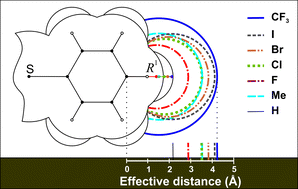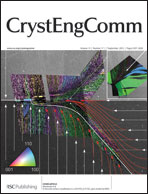XPac dissimilarity parameters as quantitative descriptors of isostructurality: the case of fourteen 4,5′-substituted benzenesulfonamido-2-pyridines obtained by substituent interchange involving CF3/I/Br/Cl/F/Me/H†
Abstract
Crystal structures of fourteen 4,5′-substituted benzenesulfonamido-2-pyridines, with tautomeric forms R1–C6H4–SO2–N![[double bond, length as m-dash]](https://www.rsc.org/images/entities/char_e001.gif) C5NH4–R2 or R1–C6H4–SO2–NH–C5NH3–R2, and with R1 = CF3, I, Br, Cl, Me, F, H and R2 = CF3 or I are reported. Comparisons carried out with the program XPac show that all investigated structures display a common 3D arrangement of N–H⋯N bonded centrosymmetric dimers. This isostructural series is exceptional in its completeness and in the diversity of the substituents involved. Accordingly, the XPac dissimilarity index x, a measure of how far two structures deviate from perfect geometrical similarity, varies from 0.9 for the interchange R1 = Br → Cl to 9.5 for the simultaneous interchange of R1 = I → H and R2 = CF3 → I. XPac plots of individual dissimilarity parameters have been used to elucidate details of geometrical similarities and differences between structures. This indicated that the geometry is preserved most closely within bc-layers that are composed of 1D slipped stacks of N–H⋯N bonded dimers, with interlayer van der Waals interactions being dominated by R1⋯R2 contacts. The main mode of geometrical adjustment for the size of R1 is a parallel shift of neighbouring layers against one another in the direction perpendicular to the layer plane, whilst the relative orientations of molecules within each layer are altered to a much smaller extent, even for those structure pairs representing R1 substituents that are very different in size. This study shows that the ability of two compounds to crystallise in fundamentally the same crystal structure depends not only on how much their molecules differ in shape but also, critically, on the specific tolerance characteristics of the crystal packing arrangement concerned. As a comparison with the present study, dissimilarity indices are reported for a set of 24 isostructural 4,4′-substituted benzenesulfonamidobenzenes previously subjected to XPac analysis.
C5NH4–R2 or R1–C6H4–SO2–NH–C5NH3–R2, and with R1 = CF3, I, Br, Cl, Me, F, H and R2 = CF3 or I are reported. Comparisons carried out with the program XPac show that all investigated structures display a common 3D arrangement of N–H⋯N bonded centrosymmetric dimers. This isostructural series is exceptional in its completeness and in the diversity of the substituents involved. Accordingly, the XPac dissimilarity index x, a measure of how far two structures deviate from perfect geometrical similarity, varies from 0.9 for the interchange R1 = Br → Cl to 9.5 for the simultaneous interchange of R1 = I → H and R2 = CF3 → I. XPac plots of individual dissimilarity parameters have been used to elucidate details of geometrical similarities and differences between structures. This indicated that the geometry is preserved most closely within bc-layers that are composed of 1D slipped stacks of N–H⋯N bonded dimers, with interlayer van der Waals interactions being dominated by R1⋯R2 contacts. The main mode of geometrical adjustment for the size of R1 is a parallel shift of neighbouring layers against one another in the direction perpendicular to the layer plane, whilst the relative orientations of molecules within each layer are altered to a much smaller extent, even for those structure pairs representing R1 substituents that are very different in size. This study shows that the ability of two compounds to crystallise in fundamentally the same crystal structure depends not only on how much their molecules differ in shape but also, critically, on the specific tolerance characteristics of the crystal packing arrangement concerned. As a comparison with the present study, dissimilarity indices are reported for a set of 24 isostructural 4,4′-substituted benzenesulfonamidobenzenes previously subjected to XPac analysis.


 Please wait while we load your content...
Please wait while we load your content...